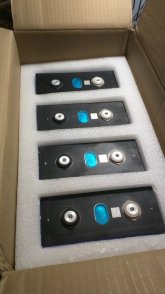Toddmccollam
New Member
- Joined
- Feb 12, 2021
- Messages
- 30
I have an RV on order, a small class C/B+ (LTV WRL-AWD), and I want to put in an electrical system for off grid camping without relying on a generator. Nations has a second alternator kit for the transit with 280 and 370 amp 12v alternators. I contacted them about higher voltages and was told they're working on 100 and 120a 48v alternators, fitting them to their test vehicle now. So that's great, and the Magnum MS4048 inverter looks good to me. Enough power to run 2 high draw appliances with a bit left over, good charging capacity, compact although heavy. The surge capacity isn't great, it can barely start the A/C which means if something else is on it might overload the inverter. But there are ways around that.
So that's all great, but it leaves the batteries. I've been looking at Lithionics, and Battleborns, and off brand stuff Will reviews like the Ampere times. They all take up a lot of space, they're expensive, and they usually fit really awkwardly in the RV compartments, leaving a bunch of wasted space. It is not a floorplan with good storage. So now I'm thinking of using the Lishen cells from varicore. 4x4 sets of them for 16 cells, connect them all in series for one 48v unit, get a single 16s BMS. I'm not sure which BMS, needs at least 150A since I want to get the bigger alternator.
My questions is, this all seems too easy and too cheap for so much benefit. I can fit 13kwh of batteries and a 4kw inverter in the space the manufacturer has 2 batteries and a 2000w xantrex, all for $2k (for the battery)? And it looks dead simple to build, at least for an engineer. I was watching an old video of Wills and he comments this is basically arts and crafts and I agree. Am I missing some factor here that makes this more expensive or more difficult than it looks, or should I get those cells on order?
I'll add solar panels eventually but they're just to extend camping time and keep the batteries charged, you can't mount enough on an RV that size to charge that battery in a reasonable amount of time.
So that's all great, but it leaves the batteries. I've been looking at Lithionics, and Battleborns, and off brand stuff Will reviews like the Ampere times. They all take up a lot of space, they're expensive, and they usually fit really awkwardly in the RV compartments, leaving a bunch of wasted space. It is not a floorplan with good storage. So now I'm thinking of using the Lishen cells from varicore. 4x4 sets of them for 16 cells, connect them all in series for one 48v unit, get a single 16s BMS. I'm not sure which BMS, needs at least 150A since I want to get the bigger alternator.
My questions is, this all seems too easy and too cheap for so much benefit. I can fit 13kwh of batteries and a 4kw inverter in the space the manufacturer has 2 batteries and a 2000w xantrex, all for $2k (for the battery)? And it looks dead simple to build, at least for an engineer. I was watching an old video of Wills and he comments this is basically arts and crafts and I agree. Am I missing some factor here that makes this more expensive or more difficult than it looks, or should I get those cells on order?
I'll add solar panels eventually but they're just to extend camping time and keep the batteries charged, you can't mount enough on an RV that size to charge that battery in a reasonable amount of time.



